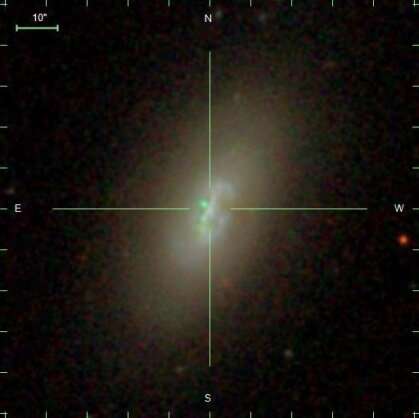January 23, 2020 report
Astronomers investigate physical properties of the galaxy PGC 26218

By conducting spectroscopic observations, astronomers from China and Spain have investigated physical properties of a nearby lenticular galaxy known as PGC 26218. The new study provides more hints about the origin of starbursts and star formation in this galaxy. Results of the observations were presented in a paper published January 16 on arXiv.org.
Lenticular galaxies (also called S0s) are considered to be intermediates between spiral and elliptical galaxies. They have a shape reminiscent of a lens, exhibit a bulge and disk similar to spiral galaxies, but do not have spiral arms.
Observations show that some lenticular galaxies have nuclear star-formation activity even after a big burst of star formation. A study conducted in 2016 found that about 8 percent of nearby S0 galaxies show signs of nuclear star-formation activity. One of them is PGC 26218 (SDSS J091705.28+252545.4), at a redshift of approximately 0.0055.
A team of astronomers led by Xue Ge of Nanjing University, China, decided to observe PGC 26218 with the Centro Astronomico Hispano Aleman (CAHA) 3.5 m telescope and the NOrthern Extended Millimeter Array (NOEMA). The main aim of this observational campaign was to study the origin of star formation in PGC 26218 in order to determine whether it follows the star formation laws as normal star-forming galaxies.
"We present 2-D-spectroscopic observations from Centro Astronomico Hispano Aleman (CAHA) 3.5 m telescope and the millimeter observation from NOrthern Extended Millimeter Array (NOEMA) of the nearby S0 galaxy PGC 26218, which shows central star-formation activity and post-starburst outside in the disk," the astronomers wrote in the paper.
As noted in the paper, PGC 26218 shows star formation in its central region and properties of post-starburst at its outskirts. The ongoing star formation process seems to prevent this galaxy from deviating the so-called star forming main sequence (SFMS).
The research found that the star-formation rate (SFR) of PGC 26218 is at a level of 0.28 solar masses per year, while the mass of molecular hydrogen was estimated to be 7.6 solar masses. Taking these results into account, the astronomers calculated that the star formation activity in this galaxy can last about 100 million years.
According to the paper, the fuel that provides PGC 26218 to form stars might come from the surrounding environment. This assumption is based on the finding that the rotation axes of stars, ionized gas and CO(J=1-0) emission line differ by more than 20 degrees, respectively, and that the difference between ionized gas and CO(J=1-0) reaches 45 degrees.
Moreover, the study found that PGC 26218 has multiple nuclear structures and the CO(J=1-0) emission line shows asymmetric profile. This allowed the astronomers to draw important conclusions regarding the origin of star formation in the studied galaxy.
"These results indicate that this galaxy may have undergone a gas-rich minor merger, which triggered the starburst a few hundred Myr ago and swept gas into the center, leading to the star formation," the scientists concluded.
More information: The physical properties of S0 galaxy PGC 26218: the origin of starburst and star formation, arXiv:2001.05679 [astro-ph.GA] arxiv.org/abs/2001.05679
© 2020 Science X Network



















